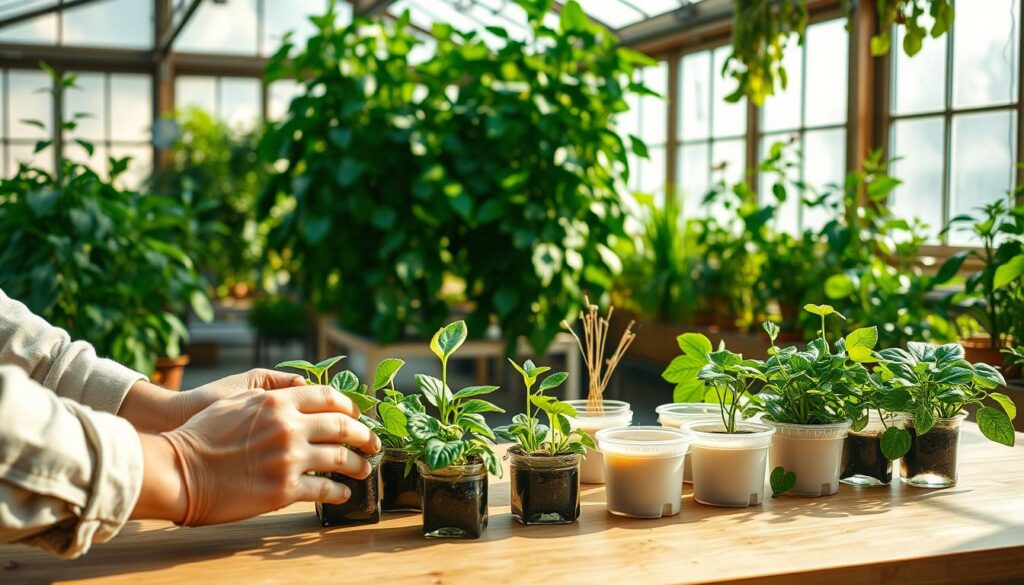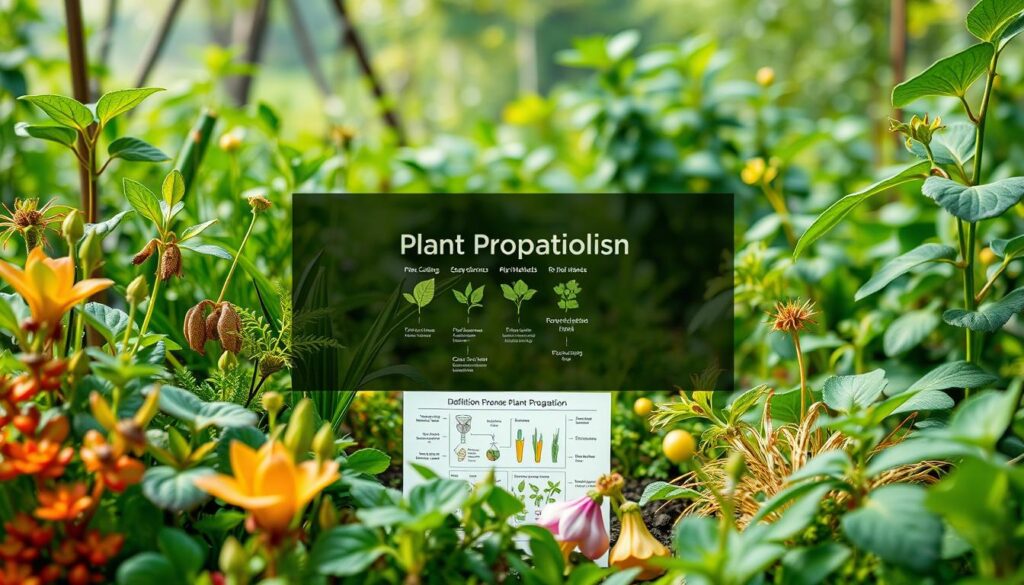Mastering Plant Propagation Techniques

About the Game
Plant propagation is a key part of gardening. It means growing new plants from seeds, cuttings, and other parts. It’s an old skill that lets gardeners add to their plant collections. It also helps them feel closer to nature by taking care of plants.
In this article, we’ll look into simple and complex ways to propagate plants. We’ll guide you through an exciting exploration of plant propagation.
Understanding Plant Propagation
For anyone digging into gardening, learning about plant propagation is vital. It’s about making new plants from existing ones. There are two main ways to do this: sexual and asexual propagation. Each method has its benefits, giving gardeners ways to grow their plant families.
Anúncios
What is Plant Propagation?
Plant propagation is how gardeners make new plants using seeds or plant parts. It’s a core skill in gardening. By mastering propagation, gardeners can grow their gardens and protect certain plants. It’s a doorway to cultivating a variety of species and saving the plants we love.
Types of Propagation: Sexual vs. Asexual
Propagation splits into two types: sexual and asexual.
Anúncios
- Sexual propagation uses seeds from flower fertilization, leading to varied offspring. It’s good for adding new traits and increasing diversity among plants.
- Asexual propagation, or vegetative propagation, involves using plant parts like stems, roots, or leaves. This creates clones of the parent plant. It’s faster and keeps the traits you want unchanged.

Benefits of Plant Propagation
Plant propagation is a useful skill for both new and seasoned gardeners. It makes gardening more enjoyable and rewarding. It helps save money and supports plant conservation efforts.
Cost Savings and Expanding Your Garden
By learning how to propagate plants, gardeners can save a lot of money. They can grow their gardens by adding more plants without buying them. This is great for growing rare or favorite plants that are hard to find.
Preserving Cherished Plants
Propagation protects heirloom or special plants for future generations. It lets gardeners keep and share unique plants that mean a lot to them. Sharing these plants makes connections through plant conservation even stronger.
Basic Methods of Plant Propagation
Learning how to start plants in different ways is key for any gardener. We’ll look at seed propagation and cutting propagation. Both methods are great and work well for different types of plants.
Propagation from Seeds
Starting plants from seeds is a basic skill. It’s vital to pick seeds that are free from disease. They need to be planted in clean soil that lets water flow through. Keeping the soil moist helps seeds to begin growing. Once they start, they need light and the right temperature to grow strong.
Stem and Leaf Cuttings
Cuttings help gardeners make new copies of their plants quickly. You cut just below a leaf joint and might use rooting powder to help roots grow. The cuttings need a warm, moist place to start growing new roots. This leads to healthy, new plants.
Advanced Plant Propagation Strategies
Diving into advanced propagation techniques offers a world of new options for keen gardeners. By learning about air layering and division, you can greatly improve your plant collection’s variety and health. Let’s explore these specialized techniques in detail.
Propagation by Air Layering
With air layering, you make a careful cut on a healthy stem. You then apply rooting hormone and wrap the cut in wet sphagnum moss. This allows roots to grow while the plant stays attached to its parent. It works great with houseplants and woody shrubs. Air layering successfully produces strong new plants that can live on their own after being cut from the parent.
Propagation by Division
Division is perfect for plants with many stems or clumps. You dig up the plant and split it into pieces, making sure each has roots and leaves. This method reduces overcrowding and encourages healthier growth in your garden. Each piece can become a new, healthy plant. This makes division both efficient and fulfilling.
Common Challenges in Plant Propagation
Getting plants to grow can be tricky. Knowing the common problems helps fix issues and grow healthy plants. Here are two main challenges and tips on overcoming them.
Rooting Failures
Rooting failures happen for many reasons, like using sick cuttings or wrong humidity. To better your chances, do these:
- Ensure cleanliness by using sterilized tools during propagation.
- Utilize rooting hormone to stimulate root growth.
- Maintain optimal light and moisture levels throughout the rooting process.
Wilting and Yellowing After Division
This problem often comes from transplant shock or not enough roots. To ease this stress, follow these steps:
- Handle roots gently during the division process.
- Water the plants immediately after division to help promote recovery.
Tips for Successful Plant Propagation
To make sure your plants grow well, you need the right setup and tools. It’s key to have the best growing spots and use rooting hormone right when you work with plant cuttings.
Maintaining Optimal Conditions
For plants to grow from cuttings, they need the perfect spot. They love warmth, moisture, and just enough light. Here’s how to give them what they need:
- Cover cuttings or seedlings with plastic to keep them damp.
- Place them where the light is soft to avoid stress.
- Check the warmth and moisture levels to keep them happy.
Doing these things can really boost your chances of success.
Using Rooting Hormone Effectively
Rooting hormone helps cuttings grow roots and is key for growth. Here’s how to use it right:
- Put a lot of it on the stem’s cut end.
- Keep the cuttings moist to help the roots grow.
- Always follow the directions on the product for the best outcome.
By following these instructions, you’re more likely to see your plants thrive.
Advanced Techniques for Plant Propagation
Exploring advanced propagation helps us find methods like grafting and layering. These improve plant growth and toughness. They let gardeners reproduce plants with good traits, making propagation more successful.
Grafting Methods
Grafting joins a piece of a plant, called the scion, to another’s roots, called the rootstock. This keeps the original plant’s traits and increases growth. Grafting uses two plants’ best traits, making it a strong technique in propagation.
Layering Techniques
Layering makes part of a plant grow roots while it’s still attached to the parent. A simple way is bending a stem to the ground and covering it with soil. This makes roots grow before separating the new plant. Layering makes new plants that are the same as the parent, which is useful in propagation.
Why Expand Your Plant Collection?
Adding more plants to your garden makes it prettier and more varied. Propagation helps a lot in this, letting you grow new plants without buying them. It makes your garden more fun and helps you bond with your plants.
Having many different plants makes your place look better and supports more life. When you grow more plants yourself, you help nature and learn to love it more. It’s also a fun hobby that teaches you new things.
- Increased variety: Different species can attract various pollinators and enhance the ecological balance.
- Cost-effective: Propagation allows you to cultivate new plants from existing ones, reducing the need for purchasing new stock.
- Personal satisfaction: Witnessing the growth of plants you propagated fosters a sense of accomplishment.
By growing your plant collection, you’re not just having fun. You’re also taking care of the environment. This is what makes it a rewarding journey.
Conclusion
Learning how to propagate plants is key to good gardening. It makes your gardening better and helps you connect more with your plants. By using different ways to grow plants, gardeners save money and get creative with their gardens. These skills make gardening better for the planet and more rewarding.
When you get into plant propagation, you help save plants. Caring for your plants means you help keep different plant types alive. You get to see your garden grow and help nature too. Using many propagation techniques means your gardening is good for the earth.
Starting to learn about plant propagation is great for everyone. It helps your garden look beautiful and helps the earth. Every time you grow a new plant, you do something good for the planet. Enjoy your gardening!
FAQ
What is the key benefit of plant propagation?
What are the main types of plant propagation?
How can I save money through plant propagation?
What methods can I use for propagating from seeds?
What is the process for taking stem and leaf cuttings?
How does air layering work for propagation?
What is propagation by division?
What are common issues with rooting failures?
How can I prevent wilting and yellowing after division?
What conditions should I maintain for successful propagation?
How should I use rooting hormones?
What are grafting methods in plant propagation?
What layering techniques can I implement?
Game Details
No
No